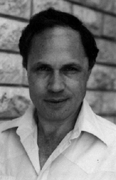Innovative Math Modeling Opens Industry Doors for Israeli Institute
December 16, 1998

The mission of the Institute for Industrial Mathematics, says its director, Adir Pridor, "is to help companies in Israel and abroad solve problems in product and process development by using mathematical methods."
The Institute for Industrial Mathematics, established in Israel on January 1, 1993, employs 18 mathematical scientists, most of them from the former Soviet Union. Located in the fast developing city of Beer Sheva, the institute was funded initially by government agencies and private foundations. By 1997, 50% of its budget came from projects with industry; for 1998, earnings from industrial contracts are projected to exceed 60% of the institute's budget.
Adir Pridor, the director of IIM, has a PhD in mathematics from Hebrew University and a broad range of experience in industry. His research areas include optimization, operations re-search, numerical analysis, and fluid mechanics.
On a recent visit to IIM, in its new location in a growing industrial park on the outskirts of Beer Sheva, I asked Pridor how he views the role of the institute. "Our mission," he told me, "is to help companies in Israel and abroad solve problems in product and process development by using mathematical methods. These problems often appear in raw form, and they are complex enough so that they cannot be resolved without innovative mathematical modeling." The solutions to these problems, he added, "often require advanced mathematical methods and sophisticated numerical implementation."
During the first five years of its existence, IIM has developed working relations with dozens of companies and completed more than 30 projects for industry. Some understanding of the institute can be gained from brief descriptions of two projects completed this year:
-
Wet stack study. The Israel Electric Corporation (IEC) is planning the construction of a new power station, with purification of exhaust gases to be done in a wet stack. The stack will cause thermal and chemical pollution of the environment. IEC requires a stack contractor to construct a 1:20 model of the stack in order to reveal the most important factors that determine the emission of pollutants; this information is used in setting up specifications for the power plant. The objective of the IIM project was to analyze all the processes that take place in a real stack, including condensation on the stack walls and in the flow, droplet sedimentation, entrainment and re-entrainment in the wall film, and the film's instability and drag-up. The analysis of the processes involves hydrodynamics (mainly Navier-Stokes equations), heat transfer, surface tension, and gas-liquid interaction and saturation. The model includes more than 20 equations and constitutive laws, which were derived by a mixture of analytical and empirical tools. On the basis of the quantitative analysis performed by IIM, IEC established specifications for the wet stack of the power station. The contractor who successfully bids for the job will have to maintain close contact with IIM to ensure that the specifications are implemented correctly.
- Armor penetration. IIM has done extensive work on the problem of armor penetration. Institute researchers have performed mathematical analysis and written codes for the design of new multilayer-fabric armor structures that absorb as much of a projectile's power as possible, and at the same time are very light and inexpensive. In their mathematical models, the researchers evaluated the performance of layered composite materials, ceramic armor tiles, and superplastic structures. The work has led to effective understanding of crack propagation and arrest, dynamic interaction of layers, and wave radiation, understanding that will undoubtedly be useful in future projects.
Other projects completed recently by IIM include:
-
The design of a ring structure for increasing the reliability of telephone networks based on optical cables;
- Development of a scheduling strategy for the optimal utilization of operating rooms for outpatients at a large hospital.
Ongoing IIM projects include the ultrasonic welding of metals and polymers, a technology used in wiring chips. Another promising project centers around the stability and design of vortex chamber separators used to separate particles of different sizes; dusty fluid enters through inlets, and the rotating blades of the separator cause a large centrifugal acceleration, which tends to separate particles of different sizes. Here the design of the blades poses an interesting mathematical problem.
Pridor pointed out that one of the key strengths of IIM is the synergy produced by the presence within the same institute of mathematical scientists with different areas of expertise. He cited as an example a project in video image enhancement. In their first attempt, institute researchers tried to enhance each frame separately. Since the transformations used for adjacent frames did not conform to each other, the enhancement as a whole was rather poor. In stepped another researcher, with a background in fluid mechanics, who introduced an additional principle based on the stabilization of mechanical systems (designed to prevent vibration). Although the introduction of the new principle did not result in an optimal enhancement of each separate frame, it did lead to a superior video image.
IIM is a unique institute in Israel. Its aim is to promote industry by going directly to companies and working with them to identify problems in which mathematical models and simulation will increase their capabilities. The fact that the portion of IIM's support that comes from industry has been increasing may serve as a source of encouragement to groups in other countries that wish to embark on a similar course.
Additional information about IIM can be found at http://www.cs.bgu.ac.il/~iim.
Avner Friedman is Regents' Professor in the School of Mathematics and director of the Minnesota Center for Industrial Mathematics at the University of Minnesota.

